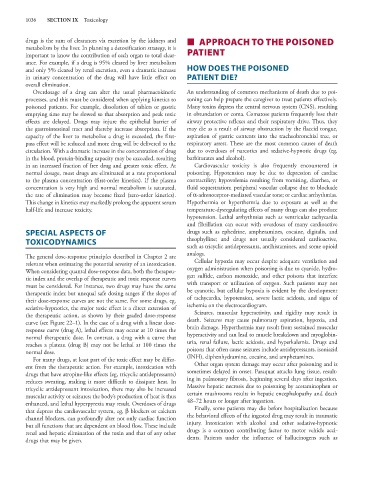Page 1050 - Basic _ Clinical Pharmacology ( PDFDrive )
P. 1050
1036 SECTION IX Toxicology
drugs is the sum of clearances via excretion by the kidneys and ■ APPROACH TO THE POISONED
metabolism by the liver. In planning a detoxification strategy, it is
important to know the contribution of each organ to total clear- PATIENT
ance. For example, if a drug is 95% cleared by liver metabolism
and only 5% cleared by renal excretion, even a dramatic increase HOW DOES THE POISONED
in urinary concentration of the drug will have little effect on PATIENT DIE?
overall elimination.
Overdosage of a drug can alter the usual pharmacokinetic An understanding of common mechanisms of death due to poi-
processes, and this must be considered when applying kinetics to soning can help prepare the caregiver to treat patients effectively.
poisoned patients. For example, dissolution of tablets or gastric Many toxins depress the central nervous system (CNS), resulting
emptying time may be slowed so that absorption and peak toxic in obtundation or coma. Comatose patients frequently lose their
effects are delayed. Drugs may injure the epithelial barrier of airway protective reflexes and their respiratory drive. Thus, they
the gastrointestinal tract and thereby increase absorption. If the may die as a result of airway obstruction by the flaccid tongue,
capacity of the liver to metabolize a drug is exceeded, the first- aspiration of gastric contents into the tracheobronchial tree, or
pass effect will be reduced and more drug will be delivered to the respiratory arrest. These are the most common causes of death
circulation. With a dramatic increase in the concentration of drug due to overdoses of narcotics and sedative-hypnotic drugs (eg,
in the blood, protein-binding capacity may be exceeded, resulting barbiturates and alcohol).
in an increased fraction of free drug and greater toxic effect. At Cardiovascular toxicity is also frequently encountered in
normal dosage, most drugs are eliminated at a rate proportional poisoning. Hypotension may be due to depression of cardiac
to the plasma concentration (first-order kinetics). If the plasma contractility; hypovolemia resulting from vomiting, diarrhea, or
concentration is very high and normal metabolism is saturated, fluid sequestration; peripheral vascular collapse due to blockade
the rate of elimination may become fixed (zero-order kinetics). of α-adrenoceptor-mediated vascular tone; or cardiac arrhythmias.
This change in kinetics may markedly prolong the apparent serum Hypothermia or hyperthermia due to exposure as well as the
half-life and increase toxicity. temperature-dysregulating effects of many drugs can also produce
hypotension. Lethal arrhythmias such as ventricular tachycardia
and fibrillation can occur with overdoses of many cardioactive
SPECIAL ASPECTS OF drugs such as ephedrine, amphetamines, cocaine, digitalis, and
TOXICODYNAMICS theophylline; and drugs not usually considered cardioactive,
such as tricyclic antidepressants, antihistamines, and some opioid
The general dose-response principles described in Chapter 2 are analogs.
relevant when estimating the potential severity of an intoxication. Cellular hypoxia may occur despite adequate ventilation and
When considering quantal dose-response data, both the therapeu- oxygen administration when poisoning is due to cyanide, hydro-
tic index and the overlap of therapeutic and toxic response curves gen sulfide, carbon monoxide, and other poisons that interfere
must be considered. For instance, two drugs may have the same with transport or utilization of oxygen. Such patients may not
therapeutic index but unequal safe dosing ranges if the slopes of be cyanotic, but cellular hypoxia is evident by the development
their dose-response curves are not the same. For some drugs, eg, of tachycardia, hypotension, severe lactic acidosis, and signs of
sedative-hypnotics, the major toxic effect is a direct extension of ischemia on the electrocardiogram.
the therapeutic action, as shown by their graded dose-response Seizures, muscular hyperactivity, and rigidity may result in
curve (see Figure 22–1). In the case of a drug with a linear dose- death. Seizures may cause pulmonary aspiration, hypoxia, and
response curve (drug A), lethal effects may occur at 10 times the brain damage. Hyperthermia may result from sustained muscular
normal therapeutic dose. In contrast, a drug with a curve that hyperactivity and can lead to muscle breakdown and myoglobin-
reaches a plateau (drug B) may not be lethal at 100 times the uria, renal failure, lactic acidosis, and hyperkalemia. Drugs and
normal dose. poisons that often cause seizures include antidepressants, isoniazid
For many drugs, at least part of the toxic effect may be differ- (INH), diphenhydramine, cocaine, and amphetamines.
ent from the therapeutic action. For example, intoxication with Other organ system damage may occur after poisoning and is
drugs that have atropine-like effects (eg, tricyclic antidepressants) sometimes delayed in onset. Paraquat attacks lung tissue, result-
reduces sweating, making it more difficult to dissipate heat. In ing in pulmonary fibrosis, beginning several days after ingestion.
tricyclic antidepressant intoxication, there may also be increased Massive hepatic necrosis due to poisoning by acetaminophen or
muscular activity or seizures; the body’s production of heat is thus certain mushrooms results in hepatic encephalopathy and death
enhanced, and lethal hyperpyrexia may result. Overdoses of drugs 48–72 hours or longer after ingestion.
that depress the cardiovascular system, eg, β blockers or calcium Finally, some patients may die before hospitalization because
channel blockers, can profoundly alter not only cardiac function the behavioral effects of the ingested drug may result in traumatic
but all functions that are dependent on blood flow. These include injury. Intoxication with alcohol and other sedative-hypnotic
renal and hepatic elimination of the toxin and that of any other drugs is a common contributing factor to motor vehicle acci-
drugs that may be given. dents. Patients under the influence of hallucinogens such as

